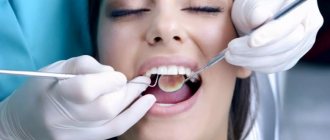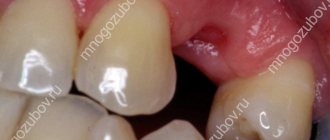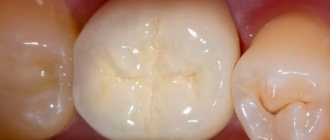Reasons for appearance
In medicine, a hole in the gum is called a fistula. A fistula appears as a consequence of the activity of harmful microorganisms that are located in the area of the alveolar process. As a rule, the causative agents of pathology are coccus bacteria.
That is, the main reason for the formation of a fistula is a large amount of pathogenic microflora in the mouth. Lack of hygiene, the accumulation of soft plaque and the formation of tartar provoke the appearance of a fistula in the gums. Over time, tartar grows and begins to put pressure on the gums. In addition, soft dental deposits spoil the aesthetics of a smile; pigment spots may appear on the enamel.
Another reason for the appearance of a fistula near a tooth may be infectious inflammation. Diseases such as tonsillitis, ARVI, and whooping cough reduce immunity, creating all the conditions for the proliferation of bacteria.
What can you do to speed up the healing process?
Only “sterile conditions” in the oral cavity will allow the wound to heal quickly, although this is a rather relative concept. There are both harmful and beneficial bacteria in the mouth. In addition, internal diseases can sometimes negatively affect the gum healing process:
- intestinal dysbiosis;
- pathological phenomena in the gastrointestinal tract, esophagus.
The main thing is to prevent the development of secondary infection of the hole, adhering to certain rules so that the wound heals and heals. So, you need to do the following:
- hold the gauze swab placed in the hole by the doctor more tightly in the first few hours after tooth extraction, squeezing with the jaws;
- stop smoking, drinking alcohol and hot solid foods for the first 2-3 days until the healing process and formation of new bone takes place;
- do not wash out blood clots, which create a kind of plug (protection) from the penetration of harmful bacteria and microorganisms;
- avoid accidental injury to the socket, i.e. it is better to chew food on the other, healthy side;
- stop playing sports, visiting saunas and overheating in the sun for 3-4 days;
- It is advisable not to sleep on the sore side of the jaw in the first days;
- rinse your mouth with herbal decoctions, although doctors do not recommend doing this to avoid washing out blood clots.
Often, out of ignorance and mistake, patients begin to vigorously rinse their mouths with various traumatic means at hand (soda, salt, hydrogen peroxide) so that the hole space heals faster, thereby aggravating the process and significantly delaying the healing time of the hole. All that happens is irritation, destruction and washing out of blood clots, and increased pain. All this may be a reason to return to the dentist and perform a secondary operation.
Of course, some adherents of traditional medicine try to minimize unpleasant symptoms using herbal infusions, decoctions and lotions. Dentists approve ointments and gels with anti-inflammatory and wound-healing effects so that the wound begins to heal faster.
The main thing is not to neglect the frequency and duration of home treatments. You can make gentle infusions and lightly rinse your mouth to remove food particles after each meal. Although in the first days it is extremely undesirable to do this. Such leaching can lead to the liquefaction of blood clots, a process of “gurgling” in the mouth.
You can use weak solutions of herbal decoctions (chamomile, sage) or Furacilin, Chlorhexidine, as pharmaceuticals. It is better to first consult a doctor and apply it carefully, without overdoing it, so that the healing of the hole occurs comfortably and gradually.
Fistula in the soft periodontal tissues after tooth extraction
The formation of a hole after tooth extraction is normal. As a rule, the hole heals within one to two weeks. If the operation was performed on wisdom teeth, the tightening process may take several weeks. Impaired socket tightening can occur due to infection or in case of injury to the area where the tooth was removed.
In a situation where the hole has tightened and a gap has formed in the periodontium, it may indicate that the tooth was not completely removed. Small fragments of the tooth gradually begin to decompose, forming a fistula.
Complications: inflammation of the socket, or alveolitis
Inflammation occurs due to infection entering the wound. You should especially beware of it if the process of tooth extraction was traumatic and difficult. Most often the problem occurs for the following reasons:
- disturbance of a blood clot in the wound;
- ingress of tooth fragments or foreign particles into it;
- insufficient sanitation of the resulting hole;
- violation of hygiene recommendations.
Signs of alveolitis may occur 2-3 days after surgery. It is impossible to confuse them with anything. These include pain, inflammation, increased body temperature, an unpleasant odor, and even the discharge of pus. If only one symptom appears, you still need to urgently go to a specialist: the problem will not go away on its own, but will only get worse.
The maximum that a patient can do to avoid complications is to follow all the surgeon’s recommendations, including hygiene ones. But do it in moderation. Take care of yourself and your health!
Fistula between tooth and gum
A hole between a tooth and periodontal tissue indicates the development of cervical caries or the complications it caused. Cervical caries can be located between the teeth and not be visible to the naked eye. Due to its inaccessible location, such caries often turns into pulpitis.
Pulpitis is an inflammation of the blood vessels and nerve endings located in the pulp chamber of the tooth. The chronic stage of the pathology may be accompanied by the formation of a purulent focus in the soft tissues. If pulpitis progresses to the next stage of periodontitis, several fistulas may appear at once.
What does gum healing depend on?
Removing the eighth teeth is particularly difficult due to the incorrect location, which occurs in 80% of people. Accordingly, the postoperative period lasts a longer period of time. The process of tissue repair depends on the following factors:
- Traumaticity of surgical intervention;
- Size and location of the eighth tooth;
- State of the immune system;
- Patient's age;
- Presence of chronic diseases;
- Individual characteristics;
- Taking medications;
- Presence of seams.
The appearance of a hole in the periodontium in a child
The formation of a hole in the gum near a tooth in a child can be due to reasons such as: periodontitis caused by complicated caries, or injury to the oral mucosa. With periodontitis, the lesion reaches the jaw bone. A cavity appears inside the periosteum, which is filled with pus. When there is an excess of pus, it breaks out through the fistulous tract, thereby bringing severe pain.
Frequent mechanical damage to the mucous membrane and gums causes infection to enter the oral cavity. Bacteria entering the periodontium cause inflammation and fistula formation.
Symptoms
This complication has very pronounced symptoms.
- Pain.
Many people perceive pain as a standard consequence of tooth extraction. This is partly logical, but over time the pain does not stop and only gets stronger. This is a clear sign of a complication. - Swelling and inflammatory process.
A tooth fragment injures soft tissues, causing swelling and inflammation. The longer you delay treatment, the stronger the inflammation. - A characteristic coating in the area of the hole.
Appears at a later stage, when the body tries to fight the inflammatory process. - Pus and bad breath.
A late stage complication that requires immediate intervention.
Symptoms
Signs of fistula formation include:
- aching pain that increases in the evening;
- burning and itching of gums;
- swelling in the affected area;
- gum hyperemia;
- increased body temperature;
- general weakness, chills;
- increased irritability;
- apathy.
The appearance of symptoms of pathology is individual for everyone. Some may experience very severe pain and discomfort in the mouth, while for others the symptoms may be almost invisible.
Symptoms of alveolitis
As a rule, the patient ignores the first symptoms of inflammation without due attention, considering them to be the norm after surgery. After tooth extraction, as already noted, pain within 24 hours is considered normal. As the hole heals, the pain subsides and completely disappears after a few days.
If the patient develops an inflammatory process, then the unpleasant sensations do not subside after a day or two, and 3–5 days after the operation, severe, throbbing pain in the socket occurs, which intensifies as the infection develops.
With alveolitis, patients may complain of both unbearable and moderate pain. Pulsation and pain are focused, as a rule, only in the removal area. However, in rare cases, the pain radiates to half of the face.
Other characteristic symptoms of alveolitis are:
- a sharp rise in body temperature;
- tooth sensitivity to hot/cold food;
- enlargement of the submandibular lymph nodes;
- decreased appetite;
- increased salivation.
In rare cases, the disease causes weakness, increased fatigue, and secondary infectious foci appear on the oral mucosa.
Treatment
If you find a fistula on the gum, you should immediately go to see a dentist. Based on the diagnosis and identification of the causes of the disease, appropriate treatment is prescribed.
Treatment can be carried out in two ways:
- drug treatment;
- surgical treatment.
If the cause of the formation of a fistula is a carious process or pulpitis, then the following treatment is carried out:
- destroyed dentin is removed;
- The cavity is processed and a filling is applied.
Then, to eliminate inflammation and remove pus, the following is prescribed:
- rinsing with antiseptics;
- antiseptic and analgesic gels and ointments;
- Antibiotics may be prescribed if necessary.
If the cause of the hole is periodontitis or an infection that has penetrated into the root of the tooth, surgical intervention is performed.
In the first case, the fistula is opened, the accumulated pus is removed through drainage, and the cleaned hole is treated with antiseptics and covered with a medicinal bandage.
When an infection occurs, not only the gums are opened, but also the alveolar process. After treatment of the tooth root, bone augmentation is performed. If the root is severely damaged and cannot be treated, the tooth must be removed.
How is tooth extraction performed?
It all starts with a consultation. The doctor will take a three-dimensional photograph, assess the location of the tooth in the jaw, the number and direction of the roots - wisdom teeth are famous for their unusual anatomy. All other human teeth are classified and have their own standard structure options, while the shape of wisdom teeth is random.
By the way, why wisdom? The point is the timing of the formation of tooth germs. All other teeth are formed in utero and after birth only continue their development and eruption. The formation of figure eights in the jaws occurs at the age of 4-5 years, and the beginning of teething occurs at an older age, hence the connection with wisdom.
After assessing the situation based on the image, you will be scheduled for surgery. At the appointment, the doctor administers anesthesia and removes the tooth. Most often, you need to make a small incision in the gum and cut the tooth into several parts; you can read more in detail here.
After removal, the additional incision is sutured, but the hole itself remains. The doctor inserts a membrane made from the patient’s venous blood into it - before the operation begins, the blood is taken and the tube is sent to a centrifuge, where the membrane is formed. Experience has shown that this will heal better and faster. A blood clot forms in the hole with the membrane, through which it will heal.
Prognosis and possible complications
If the fistula is detected and treated in a timely manner, the prognosis is favorable. If you follow all the specialist’s recommendations, within a week the resulting wound will completely heal and heal.
If proper treatment is not carried out, the following consequences are possible:
- abscess formation;
- phlegmon;
- osteomyelitis;
- tooth loss.
Preventive measures
- regular teeth cleaning;
- carrying out professional hygiene in the dental office;
- preventive examinations by a dentist every six months;
- daily consumption of fruits and vegetables.
Causes of inflammation
The disease can develop only after tooth extraction. Most often, the hole formed after removal heals within a day after the operation, and the patient feels better. But if the blood clot that covers the open wound moves or becomes deformed, an infection can penetrate into the hole, in which case alveolitis of the gums develops. As a result, the surface of the wound heals for a long time, and the patient suffers from complex discomfort.
Predisposing factors for the development of inflammation:
- Surgical injuries during complex removal. The more complex the operation, the more pronounced the postoperative inflammation of the bone tissue will be, and the more likely the release of direct plasminogen activators.
- Complex extractions associated with tooth segmentation, osteotomy, detachment of the mucoperiosteal flap. Complex operations increase the chance of developing alveolitis 10 times.
- Removal of wisdom teeth. The denser, less vascularized bone tissue adjacent to the figure eights is prone to the formation of dry sockets.
- General diseases of the patient. Alveolitis often occurs against the background of concomitant diseases. For example, patients with diabetes mellitus or immunocompromised patients are more susceptible to alveolitis due to impaired healing processes in the tissues.
- Taking oral contraceptives. The estrogen contained in these drugs may indirectly enhance the fibrinolytic process, causing the breakdown of the blood clot.
- Smoking. The direct connection between smoking and alveolitis has been repeatedly proven clinically. According to studies, the risk of socket inflammation in smokers increased 4-5 times compared to non-smokers. The incidence increased by more than 20% in patients who smoked 1 pack per day and by 40% in patients who smoked immediately before and after surgery.
- Dislocation of a bunch. If the socket is handled carelessly and there is negative pressure (for example, due to drinking through a straw), alveolitis may develop.
- Bacterial infections. Dentists agree that bacterial infections are the main risk factor for dry socket.
- Poor oral hygiene. The incidence of alveolitis increases significantly with poor oral hygiene.
- Excessive use of local anesthetics. According to some studies, excessive use of an anesthetic with a high concentration of a vasoconstrictor can provoke ischemia and make it difficult for the socket to fill with blood. This condition also increases the risk of alveolitis.
In fact, alveolitis is a fairly rare disease. According to statistics, it affects approximately 3% of patients who have undergone tooth extraction surgery. More often than not, the socket is not formed properly when lower incisors and molars are removed.
But alveolitis is especially common when removing lower wisdom teeth: according to experts, in approximately 20% of cases, the removal of “eights” with difficult eruption is complicated by alveolitis. In addition, it is believed that the risk of developing the disease is inextricably linked with age. This is explained by the fact that metabolism slows down, immunity is weakened, and the regenerative abilities of the body deteriorate.
Recommendations for speedy healing
To speed up healing, try to protect the post-extraction socket and the blood clot in it. Dentists recommend not rinsing your mouth or drinking through a straw for 24 hours after surgery. On the second day, you can carefully rinse your mouth with salted water (one teaspoon of salt per glass of warm water). Starting from the third day, you should return to normal hygiene procedures: gently brush your teeth with antibacterial toothpaste, use a soft-bristled brush and dental floss, while avoiding vigorous rinsing and vigorous spitting.
You shouldn’t give up food completely, just give preference to soft food and try to chew on the side opposite the hole. You can try to relieve swelling of the cheek by applying a cold compress to it: keep it on for half an hour, and then remove it for half an hour. Smoking and any other use of tobacco should be stopped for at least the first three days after the procedure.
Tooth extraction is a traumatic process, but healing begins quickly after it. After just a few days, you may not even remember that your tooth was removed. Take care of the safety of the hole and the tissues around it, follow the dentist’s recommendations, and then you will have a speedy and safe recovery.











